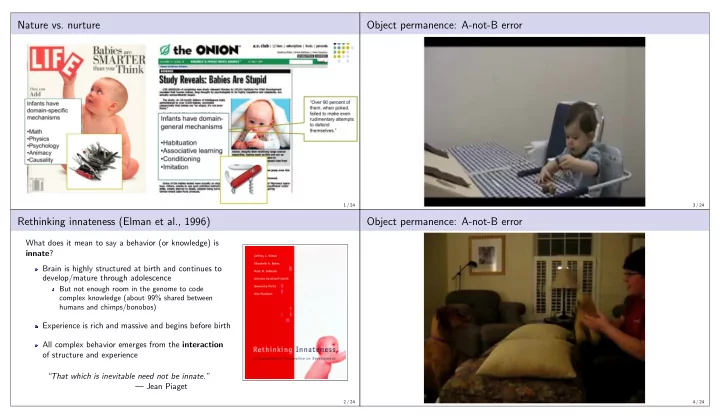

Nature vs. nurture Object permanence: A-not-B error 1 / 24 3 / 24 Rethinking innateness (Elman et al., 1996) Object permanence: A-not-B error What does it mean to say a behavior (or knowledge) is innate ? Brain is highly structured at birth and continues to develop/mature through adolescence But not enough room in the genome to code complex knowledge (about 99% shared between humans and chimps/bonobos) Experience is rich and massive and begins before birth All complex behavior emerges from the interaction of structure and experience “That which is inevitable need not be innate.” — Jean Piaget 2 / 24 4 / 24
Object permanence Munakata et al. (1997) When a toy is moved and hidden, young children will continue to search in the old Puzzle: Why do infants show sensitivity to occluded location, even though much younger infants “know” that hidden objects continue to exist objects and show an ability to retrieve objects but fail to retrieve occluded objects? Perhaps infants “know” the occuluded object exists but lack the means-ends ability to retrieve it. Munakata et al. trained 7 mo infants to retrieve distant objects lying on a towel, separated by a transparent or opaque barrier Infants had no difficulty retrieving object viewed through transparent barrier Lack of “object permanence” when reaching (vs. looking) not due to differences in means-ends demands 5 / 24 7 / 24 Object permanence (cont.) Model (Munakata et al., 1997) 6 / 24 8 / 24
Training 9 / 24 11 / 24 Analysis of hidden representations Persistence of object information over occlusion steps 10 / 24 12 / 24
Memory for object “features” Dissociation of looking vs. reaching 13 / 24 15 / 24 Memory for familiar vs. unfamiliar objects A “critical period” in language learning? (Elman, 1991) S → NP VI . | NP VT NP . NP → N | N RC RC → who VI | who VT NP | who NP VT N → boy | girl | cat | dog | Mary | John | boys | girls | cats | dogs VI → barks | sings | walks | bites | eats | bark | sing | walk | bite | eat VT → chases | feeds | walks | bites | eats | chase | feed | walk | bite | eat Simple recurrent network trained to predict next word in English-like sentences Context-free grammar, number agreement, variable verb argument structure, multiple levels of embedding 75% of sentences had at least one relative clause; average length of 6 words. e.g., Girls who cat who lives chases walk dog who feeds girl who cats walk . After 20 sweeps through 4 sets of 10,000 sentences, mean absolute error for new set of 10,000 sentences was 0.177 (cf. initial: 12.45; uniform: 1.92) 14 / 24 16 / 24
The importance of “starting small” (Elman, 1991) Results: Prediction error Training was successful only when “starting small” Trained on only simple sentences before gradually introducing embedded sentences Trained on full language but with initially limited memory that gradually improved Consistent with Newport’s (1990, Cog. Sci. ) “less is more” hypothesis Child language acquisition is helped rather than hindered by maturational limits on cognitive resources Alternative Hypothesis: Need to start small was exaggerated by lack of important soft constraints inherent in natural language SRN’s learn long-distant dependencies better when intervening material is partially correlated with distant information (Cleeremans et al., 1989, Neural Comp. ) Soft semantic constraints —distributional biases on noun-verb co-occurrences across Disadvantage for “starting small” that increases with reliability of semantic constraints clauses—provide such correlations 17 / 24 19 / 24 Simulation 1: Semantic constraints (Rohde & Plaut, 1999) Relation to Elman’s (1993) results Exact replication, varying Replication of Elman (1993) simulation with Intransitive Transitive Objects magnitudes of initial random addition of constraints on verb arguments Verb Subjects Subjects if Transitive weights chase – any any Parametric variation of reliability of semantic feed – human animal Simulation 1 used ± 1.0 ; constraints across clauses bite animal animal any Elman used ± 0.001 ( A = none, ..., E = 100% reliable) walk any human only dog Very small initial weights eat any animal human Minor improvements in technical aspects of bark only dog – – prevent effective simulation (e.g., error function, initialization) sing human or cat – – accumulation of error derivatives Compared two training regimens : Complex : Trained on full language throughout 25 epochs through 10,000 sentences (75% complex) Simple : Trained incrementally 5 epochs on simple sentences; 5 on 25% complex; 5 on 50% complex; 10 on 75% complex 18 / 24 20 / 24
Simulation 2: Native vs. late bilingual acquisition Results: Early-bilingual acquisition Languages English : Analogous to language from Simulation 1 German : German vocabulary (“hund” vs. “dog”), gender marking, case-marking in masculine, verb-final relative clauses Phoneme-based input and output representations Training Conditions Monolingual : Trained on either English or German 6 million sentence presentations sampled from corpus of 50,000 sentences Native Bilingual : Trained on both English and German (50/50) 6 million sentence presentations sampled from two corpora of 50,000 sentences each Language selected randomly every 50 sentences Late Bilingual : Monolingual training followed by bilingual training Testing Late Bilingual tested on L2 (new sample of 5,000 sentences) Even relatively brief exposure to monolingual L1 impacts subsequent L2 acquisition All results counterbalanced for English vs. German 21 / 24 23 / 24 Results: Acquisition Language learning: Conclusions Introducing soft semantic constraints aids learning of pseudo-natural languages by simple recurrent networks No need to manipulate training environment or cognitive resources Networks inherently learn local dependences before longer distance ones Critical-period effects may reflect entrenchment of representations that have learned to perform other tasks (including other languages) No need to introduce additional maturational assumptions (e.g., “less is more”) Initial monolingual training impedes subsequent bilingual acquisition Native bilingual acquisition is only slightly worse than monolingual acquisition 22 / 24 24 / 24
Recommend
More recommend